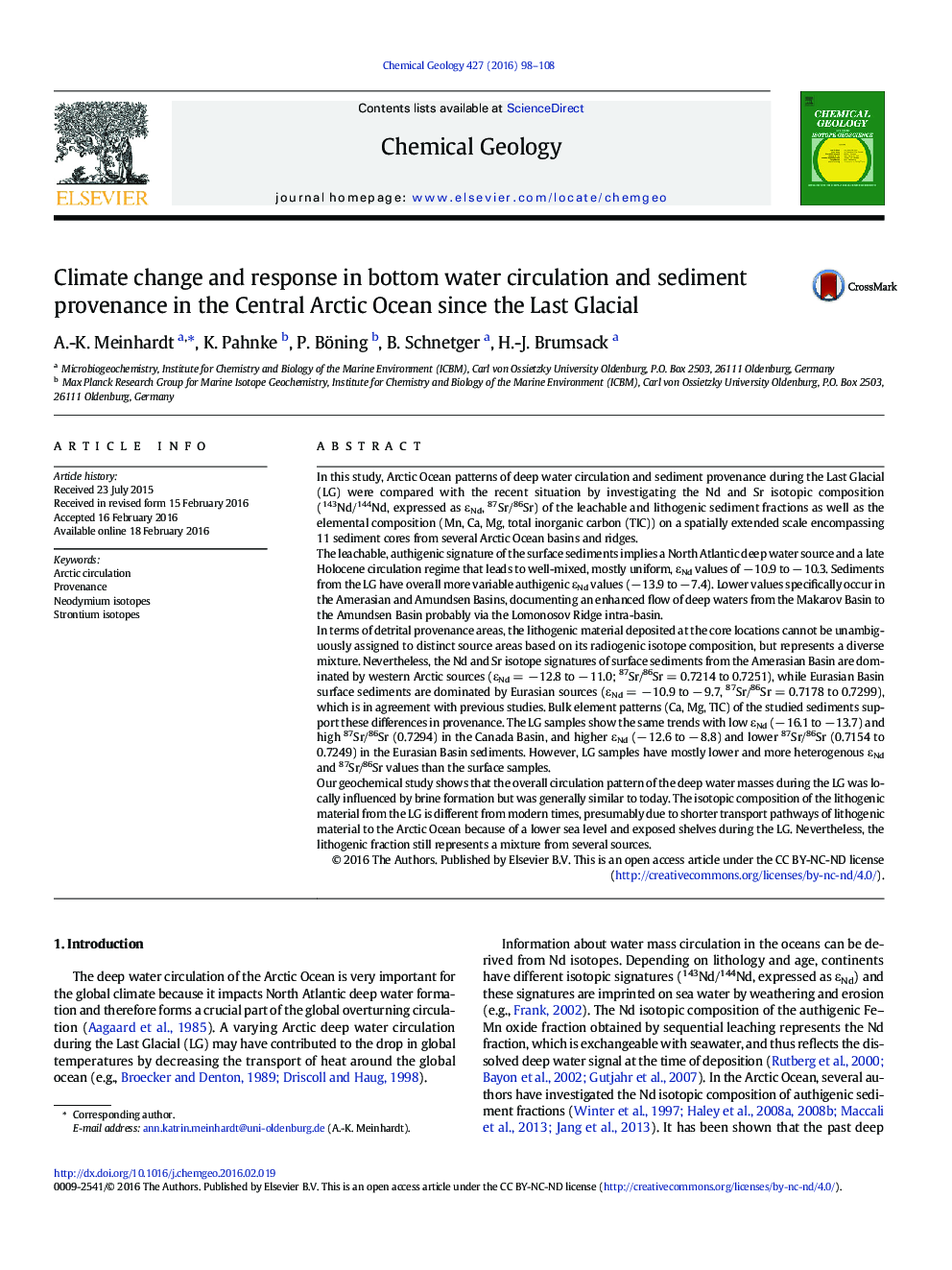| کد مقاله | کد نشریه | سال انتشار | مقاله انگلیسی | نسخه تمام متن |
|---|---|---|---|---|
| 6436146 | 1637547 | 2016 | 11 صفحه PDF | دانلود رایگان |
- Authigenic εNd values of surface sediments show a well-mixed deep water circulation.
- During the LG local influences like brine rejection occurred.
- Lithogenic εNd and 87Sr/86Sr values show mixed provenance from different sources.
In this study, Arctic Ocean patterns of deep water circulation and sediment provenance during the Last Glacial (LG) were compared with the recent situation by investigating the Nd and Sr isotopic composition (143Nd/144Nd, expressed as εNd, 87Sr/86Sr) of the leachable and lithogenic sediment fractions as well as the elemental composition (Mn, Ca, Mg, total inorganic carbon (TIC)) on a spatially extended scale encompassing 11 sediment cores from several Arctic Ocean basins and ridges.The leachable, authigenic signature of the surface sediments implies a North Atlantic deep water source and a late Holocene circulation regime that leads to well-mixed, mostly uniform, εNd values of â 10.9 to â 10.3. Sediments from the LG have overall more variable authigenic εNd values (â 13.9 to â 7.4). Lower values specifically occur in the Amerasian and Amundsen Basins, documenting an enhanced flow of deep waters from the Makarov Basin to the Amundsen Basin probably via the Lomonosov Ridge intra-basin.In terms of detrital provenance areas, the lithogenic material deposited at the core locations cannot be unambiguously assigned to distinct source areas based on its radiogenic isotope composition, but represents a diverse mixture. Nevertheless, the Nd and Sr isotope signatures of surface sediments from the Amerasian Basin are dominated by western Arctic sources (εNd = â 12.8 to â 11.0; 87Sr/86Sr = 0.7214 to 0.7251), while Eurasian Basin surface sediments are dominated by Eurasian sources (εNd = â 10.9 to â 9.7, 87Sr/86Sr = 0.7178 to 0.7299), which is in agreement with previous studies. Bulk element patterns (Ca, Mg, TIC) of the studied sediments support these differences in provenance. The LG samples show the same trends with low εNd (â 16.1 to â 13.7) and high 87Sr/86Sr (0.7294) in the Canada Basin, and higher εNd (â 12.6 to â 8.8) and lower 87Sr/86Sr (0.7154 to 0.7249) in the Eurasian Basin sediments. However, LG samples have mostly lower and more heterogenous εNd and 87Sr/86Sr values than the surface samples.Our geochemical study shows that the overall circulation pattern of the deep water masses during the LG was locally influenced by brine formation but was generally similar to today. The isotopic composition of the lithogenic material from the LG is different from modern times, presumably due to shorter transport pathways of lithogenic material to the Arctic Ocean because of a lower sea level and exposed shelves during the LG. Nevertheless, the lithogenic fraction still represents a mixture from several sources.
Journal: Chemical Geology - Volume 427, 1 June 2016, Pages 98-108
